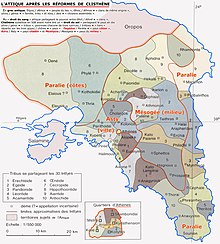
Alopece (Ancient Greek: Ἀλωπεκή, romanized: Alopeke), also spelt as Alopecae, was an asty-deme of the city of Athens,[1] but located exterior to the city wall of Athens.[2][3] Alopece belonged to the tribal group (phyle) of Antiochis.[4][5][6] It was situated only eleven or twelve stadia from the city,[7] and not far from Cynosarges.[8] It possessed a temple of Aphrodite,[9] and also apparently one of Hermaphroditus.[10]
- ^ JG Cooper – The Life of Socrates R. Dodsley, 1750 [Retrieved – 21 March 2015]
- ^ Aeschines (1 January 2010). Against Timarchus. translation and commentary by C. Carey, Professor of Greek at University College London c.2010. University of Texas Press, 1 January 2010. ISBN 9780292782778. Retrieved 22 March 2015.
- ^ The Editors of Encyclopædia Britannica - Aeschines [Retrieved 22 March 2015]
- ^ Herodotus (translated by Reverend W.Beloe) – (p.263) T. Wardle., 1839 (489 pages) copy from the University of Virginia [Retrieved 30 May 2015]
- ^ Lund University. Digital Atlas of the Roman Empire.
- ^ Richard Talbert, ed. (2000). Barrington Atlas of the Greek and Roman World. Princeton University Press. p. 59, and directory notes accompanying. ISBN 978-0-691-03169-9.
- ^ Aesch. c. Timarch. p. 119, ed. Reiske
- ^ Herodotus. Histories. Vol. 5.63.
- ^ Böckh, Inscr. n. 395
- ^ Alciphr. Ep. 3.37.